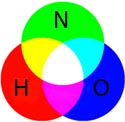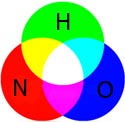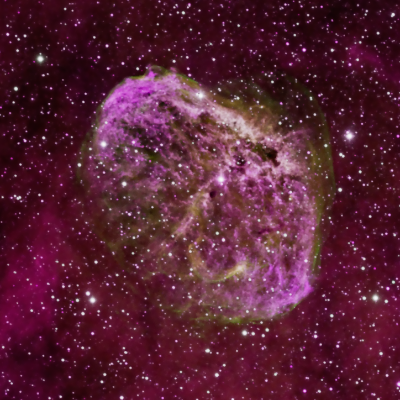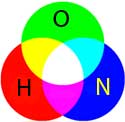
NGC 6888 area in HNO Palette




NGC 6888 in HON Palette

| Rob Hawley's Pages | Almaden Observatory Main Page |
September - early November 2011
These pages show my work to photograph the Crescent Nebula in
narrowband. I captured Hydrogen, Nitrogen, and Oxygen data
from mid September to early November 2011. This same area
was included in my 2012 project.
Click on either
of the thumbnails for a full size picture.
 NGC 6888 area in HNO Palette  |
  |
 NGC 6888 in HON Palette  |
Note that all of the images above are the same data. The
images differ on how the three narrowband colors are assigned to
Red, Green, and Blue. The differences in color represent
(roughly) differences in the distribution of various elements.
Look at the upper right of the area image. Notice the yellow
bands. These contain a strong return for Hydrogen and
Nitrogen. At least for my eyes it is easier to this displayed as
yellow. In a CFHT palette (HON) this is displayed as purple. In
the Hubble palette (center) these are yellow. The Hubble
palette also converts the purples of CFHT into aquas.
|
|
Similarly the vivid edges of the nebula are lost in the NHO image
but show clearly in HON. Note the fringes around the nebula
where the O signal is particularly strong. The crescent has
a "hat" of oxygen. For my eyes this is most easily seen when
Oxygen is mapped as green, but if you look closely at the Hubble
image you can see an area of blue.
The image above consists of
| Filter |
# Exposures |
|---|---|
| Hydrogen |
34 x 900 sec |
| Nitrogen |
31 x 900 sec |
| Oxygen |
32 x 900 sec |
From Wikipedia
The Crescent Nebula was formed by a Wolf Rayet star WR 136 of type WN6. Wolf Rayet stars of this type represent the death of massive stars. The characteristic emission lines are formed in the extended and dense high-velocity wind region enveloping the very hot stellar photosphere, which produces a flood of UV radiation that causes fluorescence in the line-forming wind region. This ejection process uncovers in succession, first the nitrogen-rich products of CNO cycle burning of hydrogen Hence it glows brightly in Nitrogen as shown in my images. .
